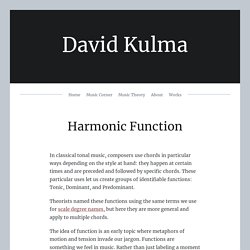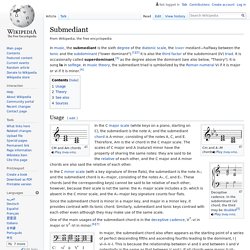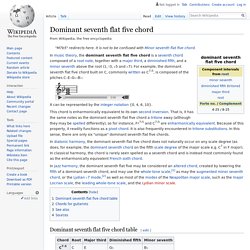

OpenStax CNX. Secondary Chords. The Circle of Fifths made clear. Jazz Piano.
Exploring Common Chord Progressions. Harmony in Western music would not exist without chord progressions – much of Western music, especially pop, rock, blues, jazz, and classical, is built on sequences of chords.

Creating a chord progression may be easy, but not all chord combinations sound good together, and if you created one at random, it’s unlikely that it would sound memorable or satisfying. If you’re trying to write the “perfect” chord progression, bad news – someone has beat you to it, and countless other someones have written songs based around this earworm of a chord progression: This particular progression is known as the I – V – vi – IV, and it’s no accident that thousands of songwriters have used it to great effect – it’s been described as a progression that sounds satisfying, hopeful, complete, and sentimental. It turns out, there’s a whole stack of these common chord progressions that gained their fame through their strong sense of purpose, direction, and resolution. Table of Contents 1. 2. 3. 4. 5. 6.
Harmony and Voice Leading - Edward Aldwell, Carl Schachter, Allen Cadwallader - Google ספרים. Studies on the Origin of Harmonic Tonality - Carl Dahlhaus - Google Books.
Harmonic Function. In classical tonal music, composers use chords in particular ways depending on the style at hand: they happen at certain times and are preceded and followed by specific chords.

These particular uses let us create groups of identifiable functions: Tonic, Dominant, and Predominant. Theorists named these functions using the same terms we use for scale degree names, but here they are more general and apply to multiple chords. The idea of function is an early topic where metaphors of motion and tension invade our jargon. Functions are something we feel in music. Rather than just labeling a moment in music, we use functions words to show how music is a dynamic force and affects our emotions.
Tonic Function (T) The tonic function is the point of repose and stability in our musical landscape. Dominant Function (D) The dominant function, on the other hand, creates tension and motion. Predominant Function (P) The Phrase Model The standard phrase model uses at least three harmonies: T-D-T. Prolongation. Harmonic functions – Open Music Theory.
NON-FUNCTIONAL CHORDS. Lecture 7. Harmony: Chords and How to Build Them. Jazz Progressions. Harmonic Progressions. Altered chord. Submediant. Usage[edit] CM and Am chords Play .

Cm and A ♭M chords Play . Play . In the C minor scale (with a key signature of three flats), the submediant is the note A♭; and the submediant chord is A♭-major, consisting of the notes A♭, C, and E♭. Since the submediant chord is minor in a major key, and major in a minor key, it provides contrast with its tonic chord. In major, the submediant chord also often appears as the starting point of a series of perfect descending fifths and ascending fourths leading to the dominant, I | vi–ii–V–I.
Wagner - Tannhauser, Zu dir wall'ich:[8] I–vi–IV–ii–V progression. Play . VI7 in C minor. Play In rock and popular music, VI in minor often uses the chromatically lowered fifth scale degree as its seventh, VI7, for example as in Bob Marley's clearly minor mode "I Shot The Sheriff".[9] Theory[edit] See also[edit] Deceptive cadence Sources[edit] ^ Benward & Saker (2003).
Harmonic Cadences. Voicing of Harmony. Guitar Lesson World. Drop 2 chord voicings are formed by taking a chord and then dropping the next to the highest note, or voice, to the lowest note of the chord.

Similarly, there are drop 1, drop 3, drop 2 & 4, etc. Drop 2 voicings are important because most of these chords are easy for a guitarist to play on 4 adjacent strings. Drop 2 is just a name for how the chords were derived from another chord. This is only important for naming the voicings. I will describe how they are derived then I will show you the voicings. The example below shows four C Major 7 chords and their drop 2 voicings in standard notation. C Major 7 Drop 2 Voicings Let’s explore the theory behind the example. Drop 2 Intervals and Notes Practical Uses and Tips The theory of drop 2 voicings is dry, but the chords they produce are fantastic because they form compact and playable voicings. To use these voicings, I recommend learning the highest note interval and the lowest note interval for each drop 2 voicing. Dominant seventh flat five chord.
It can be represented by the integer notation {0, 4, 6, 10}.

This chord is enharmonically equivalent to its own second inversion. That is, it has the same notes as the dominant seventh flat five chord a tritone away (although they may be spelled differently), so for instance, F♯7♭5 and C7♭5 are enharmonically equivalent. Because of this property, it readily functions as a pivot chord. It is also frequently encountered in tritone substitutions. In this sense, there are only six "unique" dominant seventh flat five chords. In diatonic harmony, the dominant seventh flat five chord does not naturally occur on any scale degree (as does, for example, the dominant seventh chord on the fifth scale degree of the major scale e.g.
Dominant seventh flat five chord table[edit] Chords for guitarists[edit] Dominant seventh flat five chords for a guitar in standard tuning. A♭7♭5: xx6778B7♭5: x23245C7♭5: x34356D7♭5: xx0112E7♭5: 010130F7♭5: xx3445G7♭5: xx5667[3][4][5] See also[edit]